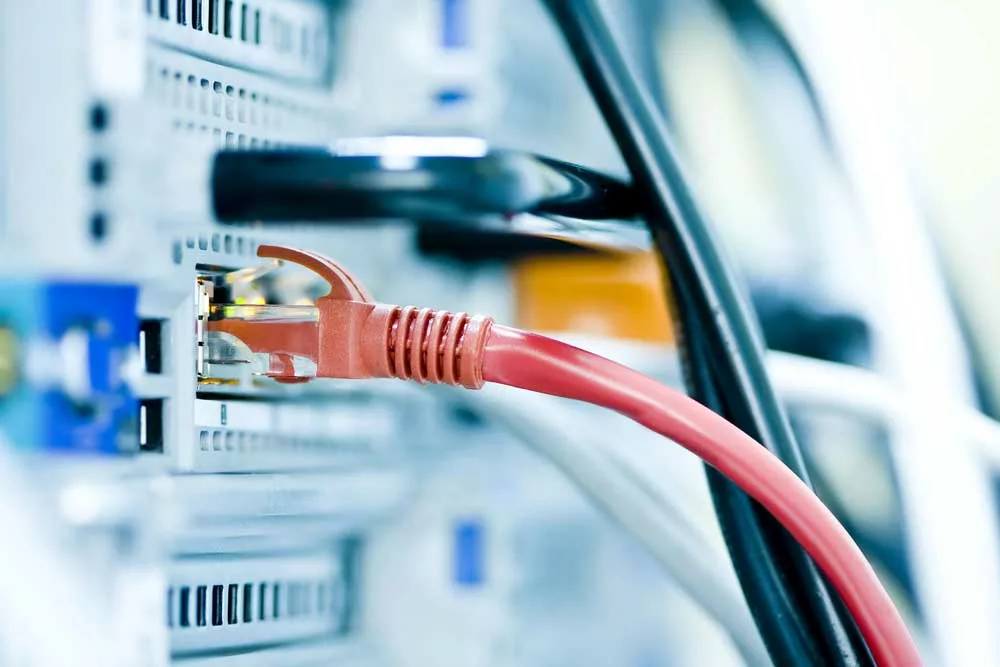When talking about ethernet cable storage, do you also think that ethernet cable’s speed increases at high temperatures?
If yes, you are wrong.
If cables are exposed to high temperatures like 250 degrees Fahrenheit, your cable will not only give poor performance but also increase the risks of fire accidents.
Most ethernet network cables come with a recommended temperature range for their working, i.e., 32 degrees Fahrenheit -140 degrees Fahrenheit.
However, the main question is how does the temperature affect your ethernet cable?
Table of Contents
- How temperature affects your ethernet cables?
- So, what are the different temperature ranges?
- Conclusion:
How temperature affects your ethernet cables?
Let’s see the effects of temperature on different aspects of cable.
Effects on ethernet cable operation:
An efficient ethernet connection has a balanced attenuation. Here, attenuation (“ping”) is the ratio of input and output power, measured in decibels.
Balanced attenuation means the signals sent at one end must equal the signal received at the other.
However, it’s not possible.
When the temperature increases, the electrons in the metal conductor start moving freely, leading to external noise and higher crosstalk. Also, with the temperature change, the cable’s insulation becomes slightly conductive due to the weird behavior of the chlorine atoms present in it.
To sum up, we can say that as the temperature rises, the attenuation also rises. As a result, the cable performs poorer than normal.
How significant is this effect?
In temperature-regulated settings or places where the temperature is 68 degrees Fahrenheit or less year-round, the generic rule for maximum ethernet cable length is applicable. And that length is around 328 feet or 100 m long.
Further, ANSI/TIA 568.2 D (a standard for copper cabling) defines the maximum length for MPTL and permanent Links as 295 ft or 90 m.
What happens when the temperature rises above 60 degrees Fahrenheit?
At higher temperatures, the cable length should be short; otherwise, you may experience signal loss over long distances, referred to as attenuation or “Insertion loss”.
Let’s understand this with the temperature de-rating chart mentioned below. Here, all mentioned lengths are using minimum 24 AWG copper (solid) Cat5e or above ethernet network cable.
Temperature de-rating chart for ethernet
| Worst case ambient temperature | Channelxxmaximum length in feet | Permanent linkxxxMaximum length in feet | ||
| Fahrenheit | shielded | unshielded | shielded | unshielded |
| 68 | 328 | 328 | 295 | 295 |
| 70 | 327 | 327 | 294 | 294 |
| 72 | 327 | 325 | 294 | 293 |
| 75 | 325 | 323 | 293 | 290 |
| 77 | 325 | 321 | 292 | 289 |
| 79 | 324 | 320 | 291 | 288 |
| 81 | 323 | 319 | 291 | 287 |
| 84 | 322 | 316 | 290 | 285 |
| 86 | 321 | 315 | 289 | 283 |
| 88 | 321 | 314 | 289 | 282 |
| 90 | 320 | 313 | 288 | 281 |
| 93 | 319 | 310 | 287 | 279 |
| 95 | 318 | 309 | 286 | 278 |
| 97 | 318 | 308 | 286 | 277 |
| 100 | 316 | 305 | 285 | 274 |
| 102 | 316 | 304 | 284 | 273 |
| 104 | 315 | 303 | 283 | 272 |
| 106 | 314 | 301 | 283 | 271 |
| 108 | 314 | 299 | 282 | 269 |
| 111 | 313 | 296 | 281 | 266 |
| 113 | 312 | 294 | 281 | 264 |
| 115 | 311 | 292 | 280 | 263 |
| 117 | 311 | 290 | 279 | 261 |
| 120 | 309 | 287 | 278 | 258 |
| 122 | 309 | 285 | 278 | 256 |
| 124 | 308 | 283 | 277 | 255 |
| 126 | 308 | 282 | 277 | 253 |
| 129 | 306 | 278 | 276 | 250 |
| 131 | 306 | 277 | 275 | 249 |
| 133 | 305 | 275 | 274 | 247 |
| 135 | 305 | 273 | 274 | 246 |
| 138 | 303 | 270 | 273 | 243 |
| 140 | 302 | 268 | 272 | 241 |
| 142 | 301 | 266 | 271 | 239 |
| 144 | 300 | 264 | 270 | 238 |
| 147 | 297 | 260 | 267 | 234 |
| 149 | 296 | 258 | 266 | 232 |
| 151 | 295 | 256 | 265 | 230 |
| 153 | 294 | 254 | 264 | 228 |
| 156 | 291 | 250 | 262 | 225 |
| 158 | 290 | 248 | 261 | 223 |
| 160 | 289 | 246 | 260 | 221 |
| 162 | 288 | 244 | 259 | 219 |
| 165 | 286 | 240 | 257 | 216 |
| 167 | 285 | 238 | 256 | 214 |
Note xx refers to the max channel length calculated on RJ45 to RJ45. There are no additional patch cables.
xxx refers to the Max. Permanent link length with two patch cables at both ends of the link. Here, Max. The length allowed is 328 feet.
Effects on ethernet cable Installation
Temperature affects not only cable performance but also its installation.
In hot climates, the ethernet cables become very soft, making it hard to pass through tough places.
On the contrary, low temperatures make the cable too stiff, making installation challenging.
Effects on ethernet cable storage and shipping
Ethernet cables comprise metals, plastic, and other materials, which show some changes with the rise and fall in temperature.
The expansion and contraction of these materials with temperature can affect their form during storage.
You may not receive your cable in the same condition as they were shipped if you store them beyond the temperature range.

Ethernet cable working environment
So, what are the different temperature ranges?
Every ethernet cable manufacturer specifies a maximum operating temperature range for cables per the ANSI/TIA 568 norms.
While mentioning extreme temperature range, manufacturers often mention the” do not exceed” range for different cable activities like storage, operating and installation.
| Cable usage | Temperature ranges |
| Storage and shipping | 20 degrees C- 60 degrees C |
| Installation | 0 degrees C to 75 degrees C |
| Operation | 20 degrees C to 75 degrees C |
Almost every type of ethernet cable, be it CM-rated, CMP-rated, CMR-rated, or CMX-rated cable, can withstand the above temperature range (mentioned in the table) for storage and shipping, operation, and installation.
Temperature swings:
Does the performance of certain cables become better at different temperatures?
Yes, it is.
Different cables are made from different materials and thus can give better performance at specific temperatures, thus shrugging off ambient temperature range.
However, you must know that if a cable performs better at a particular temperature, it does not mean you can install it anywhere.
Suppose you install a CM-rated cable in a vent where the temperature rises.
You have checked that the cable can handle temperature based on the operating temperature range.
Still, your cable is unsafe in that area as it has a risk of spreading flames during accidental fire conditions.
You will need a Plenum or a CMP-rated cable with a different jacket for vents.
Let’s understand this fact with another example.
You know that CMX cables come with an LLDPE jacket covering, ensuring resistance against water, ice, UV rays, and water vapor.
On the other hand, plenum-rated/riser-rated cables have PVC jackets and allow water vapor to travel through the jacket pores.
If the cable is installed in indoor settings, water vapor will enter and leave the cable as and when desired, and nothing goes wrong.
However, using plenum or riser cables can create problems in severe temperature fluctuation settings.
Suppose you run a riser-rated cable through a PVC conduit outdoors.
With time, these cables will allow water vapor to move in and out, but it will change into liquid before evaporating inside the sealed PVC, thus damaging the cable in the long run.

Connecting ethernet cables
Conclusion:
So, for the optimum performance of your cables, ensure that you maintain the recommended temperature range during cable applications.
However, it is still advisable not to use the same cable (even if the working temperature is the same), as the jacket type also determines the cable performance.
For any type of ethernet network cable, you can contact Cloom. Our professional team will also guide you in choosing the most suitable cable according to your setting.
